It was a pure car. Its engine vibrated, its steering was harsh, as was the clutch. When you drove it, it bounced and even became a bit uncomfortable, but it brought out the best in you, it got you involved in the driving, it became addictive, it made you smile everywhere and it convinced any enthusiast, for aesthetics, for dynamics, for sound... for everything.
But it had its problems. Quite a few problems. So BMW went back to the drawing board and with the idea of maximizing profitability, redesigned the car to solve reliability, finishes and also make more money with each car sold. The MINI R56 turned out to be a second commercial success. It was a further success. It still looked like a MINI, although it got a bit more front-end styling and began to suffer from gigantism, while losing dynamic attributes in the search for a less complicated and passionate character. We were no longer convinced as the original formula.
The problem, for BMW, is that while the sales figures tell a positive story of MINI's rebirth, the operating account tells a different story. Although there is no breakdown by brand, BMW acknowledges that MINI is far from operating at the minimum 8% profitability it expects. Why? Because it used its own engines and platform, which were very difficult to amortize with the scale of sales of the firm. Things had to be changed.
The survival and profitability of the MINI project was based on the basis of being able to use a modular platform that could be amortized in more products within BMW, since sharing platform with an external manufacturer was considered unfeasible, given that there was no interest in a B-segment car with independent rear axle. Thus was born the UKL1 project, the transverse front-engine, front-wheel drive (or all-wheel drive) platform that will give life to the 1 Series, 2 Series Active Tourer, and also to all the new MINI of the future.
Design
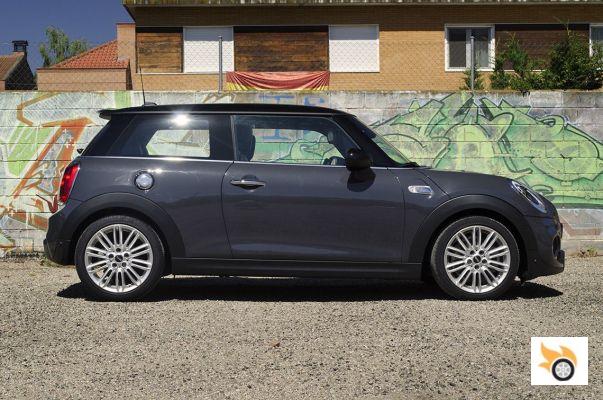
The MINI has grown again, and it's especially noticeable in the front, in the front overhang.
Being able to use a platform like the UKL1 opens the door to this third generation of the MINI. A car that has to be more cost-effective, but at the same time takes more from BMW, and can offer a more evolved chassis and electronics, as investments in more units can be amortized.
With all this in mind, the MINI F56 is born. The use of this new platform, and the various needs put on the table, make it grow even more: 9.8 extra centimetres in length and 4.4 centimetres in width. No, it's not so MINI anymore. And that brings us to the design assessment.
When we saw the first pictures of the new Cooper S, it certainly didn't make a good impression. As I've said on many occasions, the best of the new MINIs aesthetically is the first one, Frank Stehpenson's original. The second one lost many elaborate attributes, such as the bonnet, in favour of a more economical manufacturing process. This third one goes a step further in the growth and loss of Stephenson's original concept, but for other reasons.
Although it's a Cooper S, the new F56 doesn't look as quick to the eye as it is on the road. It's a wolf in sheep's clothing
The original idea for the new MINI was "wheels at the ends", and almost no overhangs. Unfortunately, the F56 can only keep that promise in the rear end. The nose has a huge overhang, which is further emphasized by the shape of the bumper and air intake.
The problem with the MINI is that, with the current pedestrian protection regulations imposed by the European Union, it's very difficult to make a different car. Add to that the fact that the platform used (which delimits geometries such as the distance from front axle to bottom bracket, front axle to A-pillar and front axle to front bumper cross member) is designed to accommodate much larger cars, and you have the second reason for the front-end gigantism of this car, which is "the smallest that can be made on the UKL1".
All in all, and far from continuing to explain "the why of things", we'll tell you that live the car looks better than pictured, but it looks big. It tastes and smells like a MINI, yes, but a grown up MINI, and in that sense it misses the lightness of the original R53.
The rear lights, as big as they may look in photos, work better in person, and the slightly wedged waistline, with an almost straight roof, as always, manage to give the car a bit more dynamism, supported by wheels that work well with the unpainted plastic wheel arches, which mask the large amount of side sheet metal lacking styling lines to tighten the surface. It doesn't need them, because it retains "that MINI flavour".
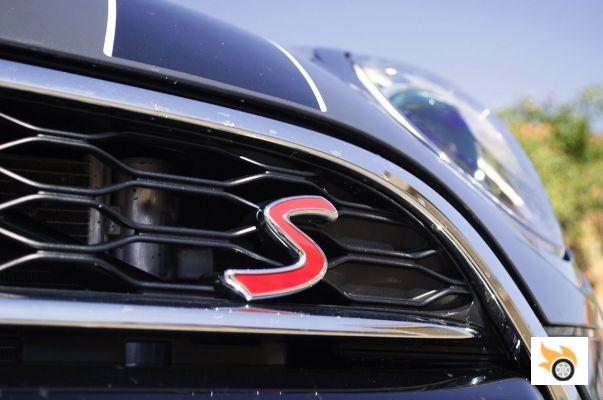
Aesthetically, I'm still sticking with the first "new MINI" Cooper S, the R53.
The old genuine gills are gone, and there's only a slit in the fins to simulate them. The bonnet air intake is also fake. It was born on the R53 to cool the intercooler, but since the R56 it has been there purely for aesthetic differentiation.
The lower intakes on the bumper are real, and serve to vent the brakes. The rear is dominated by the typical two exhaust tails centered in the bumper.
The level of attention to detail is more accomplished than ever, it's a better executed car on the outside.
If you ask me to give you my opinion of the aesthetics as a whole, I'll tell you that it's not particularly aggressive. As I said above, yes, it looks and is a MINI, and yes, the R53 was nicer, but the R53 also had some aggressiveness, some muscle -I'm not sure where- that made you realize that the Cooper S wasn't just an ordinary car.
The problem, for me, of this Cooper S is that it looks like just another MINI and it doesn't anticipate on the outside how (much) it runs afterwards. That trump card will have to play the JCW when it hits the market in a matter of months.
Cabin
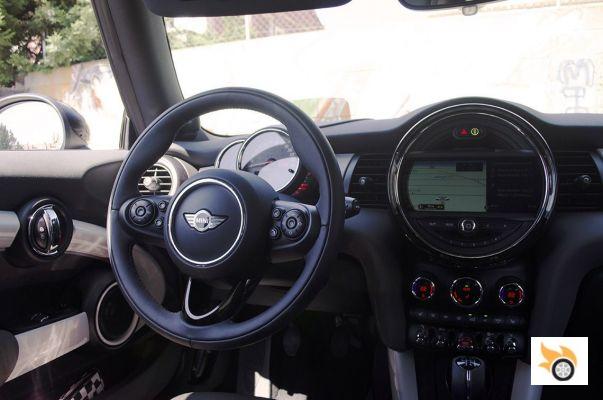
Opening the door, the ambience still retains that MINI spirit, although a lot of things have changed. I was one of those who criticized the brand for eliminating the mythical central speedometer, which although of little use (at the end you could see the speed in digital on the lap counter behind the steering wheel), it gave that retro and interesting touch to the car.
All materials and settings have taken a leap forward in quality brutal, at least in terms of sensations, because the quality of the settings will prove the time.
The driving position is still very good. It is one of the B-segment cars where you can sit better, with legs quite extended, a steering wheel that falls just where you want, with the inclination you want, and seats that hold well and have multiple adjustments, unbecoming of the category, such as the length of the bench or the width of the seat.
All the controls are now closer to hand than before, although the fuel level indicator (a series of LED lights) leaves something to be desired in its ability to attract our attention. All in all, the MINI Cooper S is the car with the best interior feel and feel of the entire B-segment.
The front seats have gained a lot, for seats and finishes, the rear are still fair, and the trunk is small for what measures the car on the outside
If we have to sit in the back, access to the seats is a little more complicated than in many of its rivals. There's more room than in previous generations, but it's still not a "big" car in the back. While there is room for your knees, sliding your feet under the front seat (which is very low) is complicated, which limits you a bit. There is only homologation for two seats in the back, and in that sense, better, because this way there are two seats well supported (a third person would fit badly and would compromise the design of the seat).
The trunk (211 liters) is very tight, especially for what the car measures on the outside. And with all that has gained nose and dimensions in general, one expects a more capable trunk and above all more usable, because not only is just liters, but has a very limited height from the floor to the tray.
Technique and technology
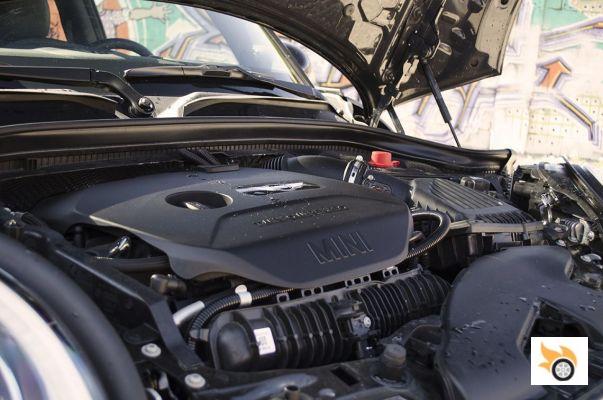
In a market where downsizing is being imposed, BMW has taken a quite different path for this Cooper S, thinking mainly about what is to come. While the One and Cooper are content with three-cylinder blocks of 1.2 and 1.5 liters respectively that, in the case of liter and a half could have been tightened to reach the 192 horses of this Cooper S, the firm wanted to have its four-cylinder in line of two liters. The idea is that this engine, with much more potential for preparation (up to about 250 horsepower without much trouble), serve as the basis for future JCW, which the brand will raise more with an approach "a la BMW M", which will differentiate them more from the mundane versions.
But focusing on the Cooper S, we'll tell you that it has, in addition to those 192 horses between 4,700 and 6,000 rpm, 300 Nm of torque between 1,250 and 4,750 turns. This speaks of a very full engine throughout the torque curve. It has an average fuel consumption of 5.7 litres, and promises a 0-60 in 6.8 seconds, on the way to a top speed of 235 mph.
The chassis has McPherson struts at the front and a multi-link system at the rear, which remains unique in its category. Its claimed weight is 1,235 kilograms, which leaves it in the segment average.
In the case of our test car, the damping is piloted, changing settings depending on the position of the driving mode selector. This has three operating programs, which are chosen via a switch built into the base of the gear lever. It's closer to hand than you might think.
Driving
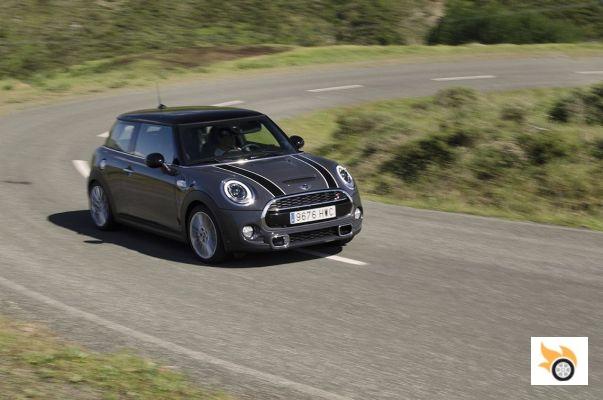
On the open road the car demonstrates a much more mature, controlled handling and a commendably quiet ride.
Let's assume that the Cooper S buyer is a customer who already likes sporty cars, because this will influence all the ratings. Unlocking and starting the car is child's play, as you can do everything with the key in your pocket.
The cabin is much better insulated than before. Visibility, thanks to the very vertical pillars, is still very good, and is aided by MINI's parking assistance system, which includes a camera and can include an automated parking system.
The gear selector on the six-speed manual transmission also has a more positive feel than before, more "BMW-like". The pedals are perfectly positioned, and cruising is child's play. Is the suspension stiff enough for this sort of thing? That's a matter of taste. Without a doubt, it is firmer than in a conventional utility car, but if we value it as what it is, a sports car, then things change. It is a car that goes hard, but the damping is very successful, perfectly controlling the movements of the body.
The difference in damping between the three possible driving modes (eco, normal and sport) is not clearly noticeable in these tasks, where the soft and hard position do not take too much.
Some may complain about the stiffness of the suspension, but the reality is that, in my opinion, it's a very bearable firmness. And there is no longer that bouncy feeling that we had in the previous Cooper S. Compared to its rivals (Clio RS, 208 GTI, Fiesta ST), the MINI also has a more "mature" ride.
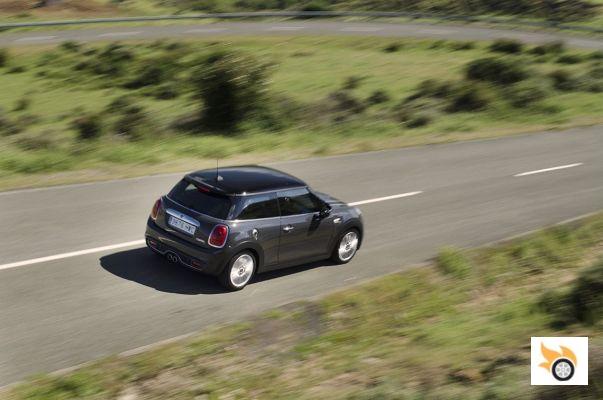
When it's time to take to the road, the MINI's maturity becomes even more apparent. Here again we are surprised by the soundproofing of the cabin, much more successful than in past generations and its rivals. The steering is perfectly filtered and the car handles perfectly the passage through different asphalts without trying to follow bumps or ruts.
The suspension, here, works in an exemplary way, containing body movements and going over bumps without upsetting the trajectory. There's no lack of damping as before, so there's no bouncing and bouncing, and, although you're riding on a hard car, the comfort of the interior, seats, ambience (achieved by the sound system), would allow you to travel to the ends of the earth.
The infotainment system is very similar to that seen in BMW (virtually identical, in fact) and the new large circular selector system with touchpad makes navigating it much easier now. The head up display is also very interesting for controlling speed and navigator commands, while the auto adaptive cruise control (which works via a camera mounted on the windscreen), allows you to keep pace and distance from other traffic, although it is sometimes a little abrupt in its action on the brakes when it detects a car in your lane that you're approaching and you haven't yet initiated the lane change manoeuvre to overtake it.
At conventional speeds, combining open road and city use, you can have consumption of about 6.5 liters per 100 kilometers, which speaks very well of this two-liter engine, more with the reserve of torque and power it has, as you can give gas at almost any speed and have a strong response.
But what if you're heading for the curves? Well, this is where a Cooper S has to shine. We tackled the first few with the normal driving mode selected. Squeezing the throttle hard from almost idle gives you a strong push. Here the engine starts to let itself be heard a bit.
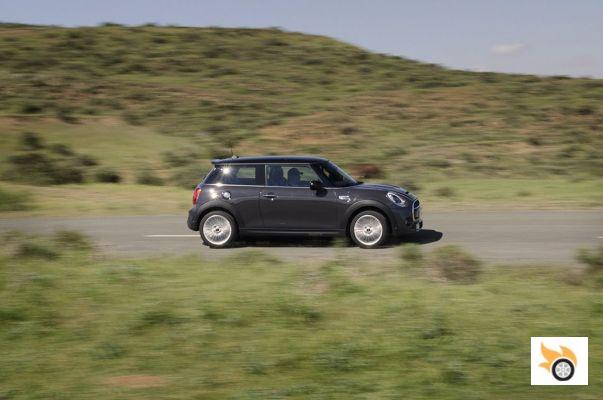
The chassis is not so bouncy anymore. Now it controls much better, and is more predictable, but also "a bit less karty".
After a few gears in, you face your first hard braking and put your foot on the brake. It has a little dead travel and then responds with forcefulness, but the pedal is not one of those hard ones that allow you to modulate power to the millimetre, it's a little softer, more "all-purpose". The back of my foot looks for the accelerator to execute two toe-taps in the downshift, and while I'm at it I see that the car "does something strange". It's not my gas pedal strokes that I see reflected in the gearbox.
The Cooper S has a built-in automated toe-tap system for downshifts, which is activated when you pull out of one gear and go to downshift to another while braking and depressing the clutch. While it's good for those who don't normally do heel-toe, because you can brake more forcefully and take advantage of downshifts to get more out of engine braking without unbalancing the car, the truth is that, for my taste, it should be easily disconnectable. And the system is not as fast and efficient as a good "manual" toe-heel. To be honest, in the end, if you want automatic devices, you buy an automatic car, and if you go for a manual to have fun doing things yourself... at least in my case, you don't want these things.
With the downshift complete, I put the steering wheel in, with perfect weight and feel and a fairly direct gear ratio, and the nose of the car is inscribed in the curve. The violence of the indication makes the car flutter a hair before finding solid support. I realize then that this has more to do with the selected suspension setting than anything else.
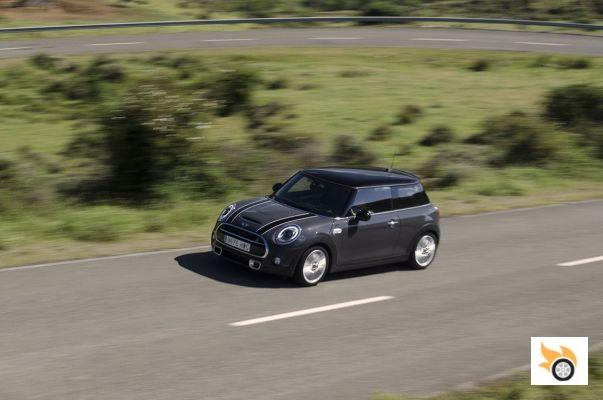
In cornering it has a good composure and the only thing that leaves the party before the account are the Pirelli P7 Cintauro, insufficient for a car of this approach.
So I exit the corner and enter the "Sport" mode for engine and chassis. It's immediately noticeable. With almost 25% of the throttle travel you do everything, because it concentrates much of the acceleration. The engine feels much more forceful, although there is less calibration with the right pedal.
The straight is short before the thrust of the engine, which seems much more powerful than those 192 horses promised. In fact, it feels more thrusting than the 200-horsepower 1.6 of the 208 GTI, for example. In large part, this feeling is due to the shape of the torque curve, which is much fuller at the bottom, making you literally eat up the gears.
And that's because the engine wants you to change gear at 6,000 revs or less, and that comes very quickly. The gauge cluster leaves the rev counter in a very secondary place, so you barely notice that you're reaching the cut-off speed, and the engine seems to want to keep stretching. Something tells me that JCW models with this engine will stretch to 7,000 revs with no problems.
So you're left with the feeling that "the engine runs out early", being a continuous torrent of torque on thrust (there's no huge concentrated kick, but rather the whole passage from 2,000 to 6,000 revs is a kick in itself).
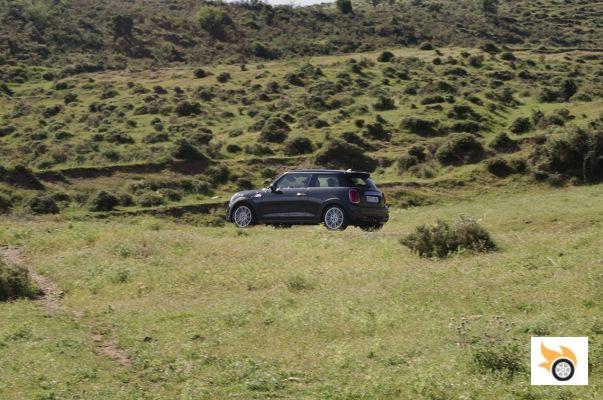
It's now a faster, more effective and easier car to get the most out of, although the rear end doesn't come into play as much as it used to.
The next corner is a very wide and round uphill hairpin. Foot on the brake, the car stops where you want it to, you put the steering wheel in, and with the suspension in its sportiest mode, it gives you great body control. You can feel the car roll out of the corner, but in a very controlled way. It's quick and firm, while the steering pulls the car into the corner. If you're unlucky and there are bumps or imperfections in the line, there's no more fear of bouncing and bouncing like in past generations, but it eats up everything much better. It has a bigger car's footprint, come on.
If you force things, the car ends up going upside down, but it's not very "stubborn", tending fundamentally to neutrality. Although you can not play with the rear unless you do "the brute", we must recognize that its cornering is quite entertaining and positive, which makes you enjoy linking kilometer after kilometer of a mountain pass.
The only problem in this aspect were the Pirelli P7 Cintauro installed on the test unit. Its lateral grip is completely insufficient for a car of these aspirations, saying "enough" much earlier than expected. With other, sportier shoes, things would probably change, but the need to use run-flat tyres always complicates the choice.
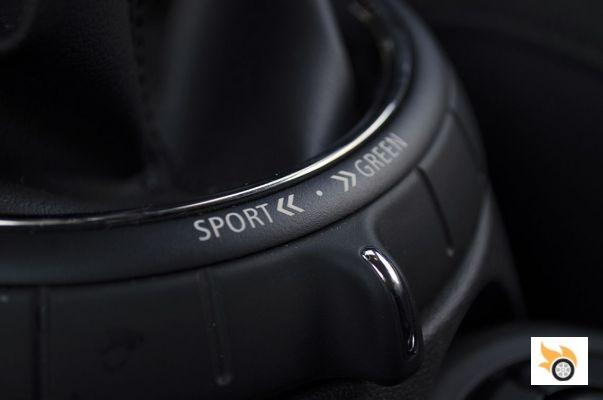
Adding to the driving enjoyment is the sound of the exhaust. In downsizing, MINI has embedded a throaty exhaust note in the exhaust that is truly spectacular and eye-catching. So much so that, unexpectedly, I got out of the car after the first five corners to check that the exhaust was fine, and the sound was genuine and voluntary; it wasn't a technical fault.
Could this MINI be any more fun to drive? Yes, it could. Although it's a 'positive' car, it's a long way from giving you those sensations that a Fiesta ST does in terms of rear-end attitude control. There's no doubt that the chassis and engine have huge potential to create "the ultimate sports utility vehicle", and MINI has, in that respect, kept a lot of cards up its sleeve to offer it in association with the JCW acronym.
Conclusions
MINI has matured and this Cooper S, fully equipped, proves it. It has a much more accomplished, "big car" footprint. It's better insulated and is a better car to put in the miles. It doesn't lose that somewhat sporty feel, thanks to a stiff suspension, but it does have better body control, thanks to better suspension geometry, better damping and more available travel.
It still has some drawbacks in aspects such as the rear seats and the trunk. It is not a car for four people to go on holiday. The problem now is that some of its rivals (Clio RS, for example) do offer these qualities mixed with the sporty spirit.
Where it stands out is in perceived quality and equipped technology. It has things that its rivals don't have and aren't expected to offer. The infotainment system is ahead of its rivals, it has adaptive cruise control, Head Up Display and a lot of other "nonsense" that, if you like technology and appreciate it, you will value.
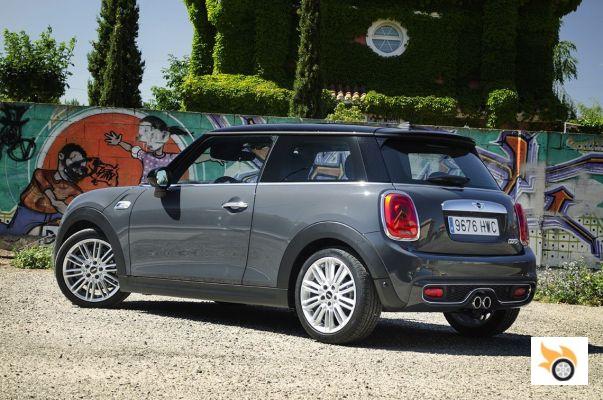
It's a much more complete car now, fast, efficient and even fun, but for the real burnouts it's time to wait for the JCW for a more uninvolving experience.
Only the Audi A1 can offer a similar premium approach in the segment, and its performance isn't quite up to the MINI's dynamic standards.
The problems for this Cooper S lie elsewhere. If you're looking for a MINI Cooper S for fun, cooler to look at when parked, I'd recommend an R53 JCW first. Why? They're much more barbaric and while they're not as accomplished for everyday use, in my opinion they look better and have more of a "go-kart" character, which also means they're bouncier cars.
If you're looking outside of MINI, cars like the Fiesta ST offer an even more interesting driving experience, but of course they don't have the equipment or the chic halo of this British car. They also cost considerably less money (the MINI Cooper S now starts at £25,950, options aside, over £4,000 more than a Fiesta ST). The MINI is... more Golf GTI, good in everything, radical in nothing, while the Fiesta ST is more Mégane RS. I'm sure you get my drift.
Overall, the MINI has matured, it's more car. It's more suitable for pretty much everything. It still suffers from a lack of boot space and maybe its looks have gone downhill. But right now, for composure and chassis, is among the best in the category in terms of "total sportiness" and not "radical sportiness". For burnouts like you and me, we'll have to wait for the JCW to find a new MINI-lover.
Test originally published in June 2014, recovered for Pistonudos.
























